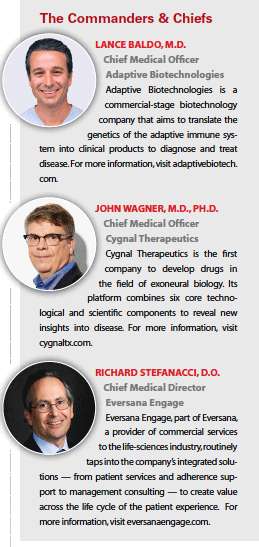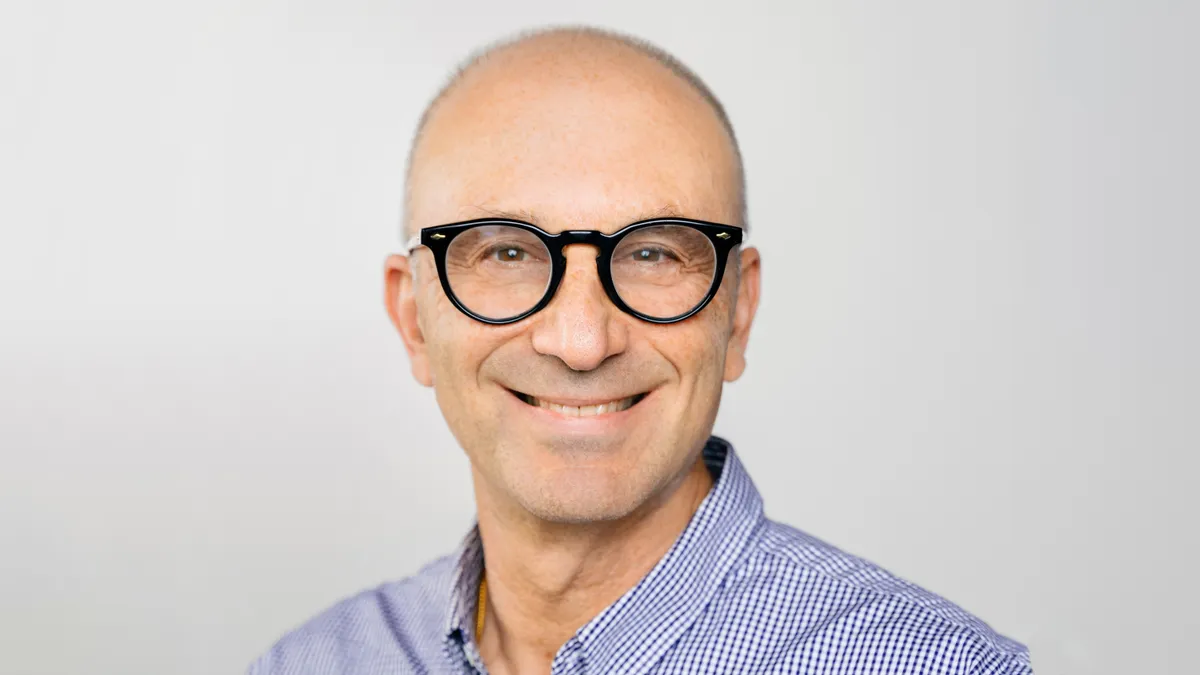It comes as no surprise that the pandemic forced companies to consider appointing medical officers to senior executive ranks. The majority of companies had to create a brand new role to lead the pandemic response and address the needs of organizations to manage global healthcare risks and exposures. According to the workforce analytics firm Burning Glass Technologies, chief medical officer postings rose from 1,776 in 2019 to 2,109 in 2020, and this hiring trend is only going to continue to expand to most organizations.
Dr. Lance Baldo
Chief Medical Officer
Adaptive Biotechnologies
Rethinking the Pipeline
 Amid COVID-19, many biotechs have been under new pressure to rethink their pipelines to address the pandemic and move through clinical development with unmatched speed and precision. This new challenge greatly impacted the role of CMOs across a wide variety of biotech companies given their intimate role in identifying how innovations could help with the pandemic, aligning the development process with regulatory guidelines, and their role in communicating nuanced scientific concepts internally and externally.
Amid COVID-19, many biotechs have been under new pressure to rethink their pipelines to address the pandemic and move through clinical development with unmatched speed and precision. This new challenge greatly impacted the role of CMOs across a wide variety of biotech companies given their intimate role in identifying how innovations could help with the pandemic, aligning the development process with regulatory guidelines, and their role in communicating nuanced scientific concepts internally and externally.
Adaptive was built around an existing platform designed to sequence, map, and characterize T- and B-cell receptors to decode how they detect and treat disease naturally. When the pandemic hit, we worked quickly to expand our partnership with Microsoft to focus on decoding the T-cell response to the virus. We didn’t know, but had a strong suspicion that T-cells might yield new insights into the disease, its impact on the immune system, as well as offer correlates for immunity and protection. My role was to help connect the dots in how our platform could be utilized given the new and ever-changing understandings of the COVID-19 virus, and in many ways this created an interesting opportunity to test a theory we had a lot of reason to believe could work.
Most biotechs rely on the expertise of their CMOs to guide them through the development and, in parallel, the regulatory process, which can mean juggling a lot of moving parts even in less trying times. COVID-19 greatly accelerated development timelines, creating a need to engage regulatory leaders at an earlier stage and working closely with them throughout the research and development process. After spending nine months mapping T cells from over 6,500 SARS-CoV-2 blood samples from subjects with COVID, Adaptive received FDA emergency use authorization (EUA) for the first in an entirely new class of diagnostic tests that use T cells in the blood to detect disease. There was no “playbook" for this, and we had to be flexible and work without always having all the answers. Our North Star was to get a tool in the hands of physicians that could help inform about the current pandemic.
Following great engagement with the FDA, T-Detect COVID was authorized to detect recent or prior COVID-19 infection based on the presence of disease-specific T cells. After this milestone, it was my responsibility to communicate the meaning of this to a variety of audiences including investors, scientific peers, policymakers, and even patients directly. Now, it is my job to continue to apply this platform to future disease states to help as many people as possible. In fact, while we were decoding the T-cell response to COVID-19, we were working in parallel to continue to identify the T-cell response to Lyme disease and Crohn’s disease.
Trend Tracking
Looking forward, the biggest trend we’re tracking is turning the biology of our immune systems into actionable data that we can use to discover and develop better diagnostics and therapeutics across many different diseases. This is the foundation of our immune medicine platform where we leverage the insights of our adaptive immune system to both diagnose and treat disease. The reason Adaptive tracks T cells in COVID-19 patients is because T cells can “remember" prior infections and give information around how the immune system recognizes a disease, attacks, and mobilizes other parts of your immune system to join the fight.
Through our partnership with Microsoft to map the human immune system, the TCR Antigen Map, we are collecting blood samples from tens of thousands of patients to generate the largest map or database of immune responses to many different diseases. The aim is to use this to get a better understanding of how our immune systems fight disease and inform the development of diagnostics and therapeutics that mimic our natural system. This ambitious effort can only be made possible by the rapid evolution of cloud computing, machine learning, and artificial intelligence.
Coping During the Pandemic
Like many CMOs, I was challenged to find ways our existing platform could be leveraged to address the COVID-19 pandemic. Additionally, it was a challenge to continuously update safety measures and research protocol amid changing CDC pandemic guidance.
Our first big challenge was grounding ourselves in our platform’s real power — to provide answers, without raising more questions. Our technology sequences, maps, and characterizes T- and B-cell receptors. It makes sense to leverage it to better fuel diagnostic and clinical care decisions. However, we are also learning that the data we are collecting is essential to understanding what constitutes immunity to the virus, as well as the durability of an immune response. That alignment with our internal team was critical in designing our development program and communicating the impact of the technology. Once we understood that larger call to action, we were better able to move forward as a collective unit with a shared goal.
It was also challenging to align with our scientific teams in-person amid ever-changing lockdown policies. We had to change how we communicated. That meant a large part of my role at the beginning of the pandemic was organizing our workflow, creating new communication channels, and creating research protocols to ensure consistency and alignment across our programs. I also worked closely to develop safety procedures and protocols for the Adaptive team when they were in the lab or office. It was essential that every one of our employees felt safe and supported throughout our critical work.
Dr. John Wagner
Chief Medical Officer
Cygnal Therapeutics
Prioritization is Key
Currently, prioritization is one of the biggest challenges for CMOs. With limited resources and many competing influences, it is crucial to effectively prioritize. This is true throughout biotech, but particularly for scientific platform companies such as Cygnal Therapeutics. We are taking an exoneural approach to discovery and development, which accounts for the role of peripheral nerves impacting diseases.
Because peripheral nerves are ubiquitous in the body, our exoneural approach has a broad reach. One important lens to prioritize is medical need through patient-centered discovery and development. With this in mind, we’ve focused on cancers with high medical need and other conditions such as inflammatory diseases. But the challenge for any platform is continuously prioritizing areas with the highest need with the advancing science.
Trend Tracking
The biggest trend we are tracking is navigating clinical work in the post-pandemic world. There are many facets to this trend, including clinical and regulatory approaches. The pandemic created challenges for clinical trial conduct across the life-sciences industry. Generally, clinical trial operations have recovered, but issues remain in pockets. On the other hand, the pandemic drove innovation in clinical trials, including virtualization of trials and rapid uptake of remote digital monitoring.
In addition, clinical studies focused on COVID-19 accelerated during the pandemic. From a regulatory perspective, this rapid decision-making led to faster deployment of successful therapeutics. Now, the public has grown to expect this level of urgency, which raises important questions. Will these learnings continue to apply? Will they extend to other areas of medical need?
Coping During the Pandemic
As with other companies, one crucial challenge as CMO was keeping Cygnal’s employees safe while also continuing to push forward our science. In the early days of the pandemic, we largely closed our doors. However, with laboratory work so crucial to Cygnal Therapeutics, we rapidly navigated a safe return to work for our scientists, including testing and enforcement of public health guidelines.
Before the emergency use approval of vaccines, it was well known that people can exhibit no symptoms while spreading the virus, so regular testing became a foundation for Cygnal’s approach. However, testing alone cannot protect employees, so safety guidelines, like social distancing and wearing face masks, became the norm. These practices, as well as rapid and transparent communication and contact tracing in the case of positive test results, were effective in keeping our employees safe — and productive — during the pandemic.
Dr. Richard Stefanacci
Chief Medical Director
Eversana Engage
A Perspective on Change
Our world is in such a rapid state of change that just identifying what’s most important can be a challenge. Bill Gates once said, “We always overestimate the change that will occur in the next two years and underestimate the change that will occur in the next 10." Determining what truly matters is critical, and having the perspective as a physician, payer, policy, and population health expert as well as patient and caregiver certainly can help. The biggest challenge I believe we face is to understand this change and being able to focus on the task at hand but also being able to adapt to new ways of thinking and delivering care. We must continue to embrace new technologies and innovations.
Trend Tracking
The biggest trend I see is a focus on value, in terms of both clinical and financial outcomes. The difficulty is that each stakeholder sees value differently. Prescription drug plans (PDPs) for example are the narrowest, with a sole focus on oral drug costs. Policy leaders, however, tend to view value in terms of the quadruple aim: total cost, patient experience, population health, and caregiver burden. Getting the right value message to the right stakeholder is critical.
Coping During the Pandemic
Engagement has been probably the most challenging aspect of my role during COVID-19. As a practicing geriatrician caring for older adults in long-term care facilities, COVID has forced isolation in many ways as we have had to try to do all we can to keep these patients safe. We’ve had to rely on phone and video conferencing in some instances, or extra layers of protection through on-site protocols. The dynamics of COVID forced a change in how we connected with patients, their families, and other stakeholders. Not only did the means of engagement change, with web-based connections replacing face-to-face, but the message also changed. We’ve had to reinvent ourselves and our approaches to ensure we reach our audiences with what they need, when they need it and how they need it. It’s been a journey, but I’m proud of how we’ve all come together to put patients first.(PV)



















